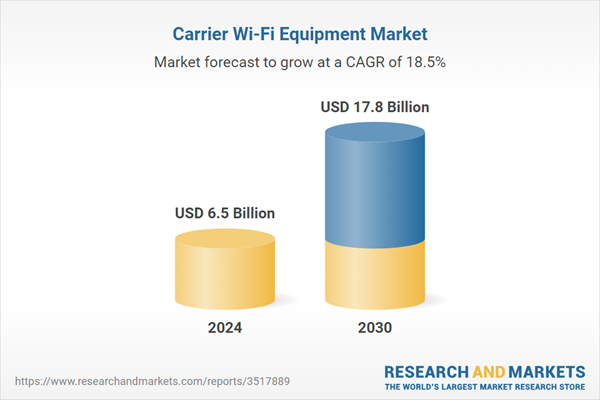The global market for Carrier Wi-Fi Equipment was valued at US$6.5 Billion in 2024 and is projected to reach US$17.8 Billion by 2030, growing at a CAGR of 18.5% from 2024 to 2030. This comprehensive report provides an in-depth analysis of market trends, drivers, and forecasts, helping you make informed business decisions. The report includes the most recent global tariff developments and how they impact the Carrier Wi-Fi Equipment market.
As 5G networks roll out, the importance of Carrier WiFi is increasingly underscored by its capability to enhance network density and support a growing base of mobile broadband users. This is particularly evident in applications spanning IoT and smart cities, where WiFi not only supplements broadband but also powers emerging technologies with high demands for network connectivity. The integration of WiFi with mobile networks facilitates a more interconnected network architecture, with dual-mode equipment adapting to the needs of an environment requiring robust and flexible internet access. In the Asia Pacific region, a notable surge in demand indicates a significant shift towards advanced network solutions, aligning regional developments with global trends towards denser, more efficient communication infrastructures.
The expansion of Carrier WiFi is catalyzed by several growth drivers, highlighting the interplay between technological advancements and evolving market demands. Hardware improvements, such as enhanced processing capabilities and extended range, enable Carrier WiFi to offer wider and more reliable coverage. The rise of smart homes and connected devices necessitates robust WiFi solutions capable of managing multiple simultaneous connections, pushing the boundaries of Carrier WiFi technology. The seamless integration with existing telecom infrastructure provides a cost-effective enhancement to current services, appealing to operators looking to expand their offerings without substantial overhauls. Additionally, the growing consumer expectation for seamless connectivity across various environments, including transitional zones between outdoor cellular and indoor WiFi networks, enhances the appeal of Carrier WiFi. Furthermore, the adoption of IoT in industrial settings and public WiFi initiatives by governments promote the use of Carrier WiFi in both public and private sectors, supported by enhanced security protocols that address increasing concerns over data security and privacy. These factors collectively drive the adoption of Carrier WiFi, ensuring its continued relevance and expansion alongside the deployment of next-generation mobile networks.
Segments: Product Type (Fixed Carrier, Mobile Carrier, Third Party Carrier); End-Use (IT & Telecom, Government, Enterprises, Utilities, Residential, Other End-Uses).
Geographic Regions/Countries: World; United States; Canada; Japan; China; Europe (France; Germany; Italy; United Kingdom; Spain; Russia; and Rest of Europe); Asia-Pacific (Australia; India; South Korea; and Rest of Asia-Pacific); Latin America (Argentina; Brazil; Mexico; and Rest of Latin America); Middle East (Iran; Israel; Saudi Arabia; United Arab Emirates; and Rest of Middle East); and Africa.
The analysts continuously track trade developments worldwide, drawing insights from leading global economists and over 200 industry and policy institutions, including think tanks, trade organizations, and national economic advisory bodies. This intelligence is integrated into forecasting models to provide timely, data-driven analysis of emerging risks and opportunities.
Global Carrier Wi-Fi Equipment Market - Key Trends and Drivers Summarized
Carrier WiFi equipment plays a pivotal role in the telecommunications sector, maintaining relevance and projecting robust growth even as the industry pivots towards the 5G era. The technology, integral in forming a bridge between traditional mobile networks and more flexible WiFi services, is crucial for fixed-line operators and wireless ISPs, as well as mobile operators utilizing dual-mode WiFi/cellular access points. This growth is largely driven by the rising adoption of SIM-based WiFi access points, reflecting an industry-wide shift towards seamless integration between mobile and WiFi networks. With significant demand particularly from the Asia-Pacific region, Carrier WiFi is becoming a cornerstone for creating more integrated, sophisticated telecommunications frameworks. The strategic focus by standards organizations on enhancing WiFi's role for IoT applications underscores its essential function in future connectivity solutions, reinforcing the technology’s adaptability and enduring significance in a rapidly evolving digital landscape.As 5G networks roll out, the importance of Carrier WiFi is increasingly underscored by its capability to enhance network density and support a growing base of mobile broadband users. This is particularly evident in applications spanning IoT and smart cities, where WiFi not only supplements broadband but also powers emerging technologies with high demands for network connectivity. The integration of WiFi with mobile networks facilitates a more interconnected network architecture, with dual-mode equipment adapting to the needs of an environment requiring robust and flexible internet access. In the Asia Pacific region, a notable surge in demand indicates a significant shift towards advanced network solutions, aligning regional developments with global trends towards denser, more efficient communication infrastructures.
The expansion of Carrier WiFi is catalyzed by several growth drivers, highlighting the interplay between technological advancements and evolving market demands. Hardware improvements, such as enhanced processing capabilities and extended range, enable Carrier WiFi to offer wider and more reliable coverage. The rise of smart homes and connected devices necessitates robust WiFi solutions capable of managing multiple simultaneous connections, pushing the boundaries of Carrier WiFi technology. The seamless integration with existing telecom infrastructure provides a cost-effective enhancement to current services, appealing to operators looking to expand their offerings without substantial overhauls. Additionally, the growing consumer expectation for seamless connectivity across various environments, including transitional zones between outdoor cellular and indoor WiFi networks, enhances the appeal of Carrier WiFi. Furthermore, the adoption of IoT in industrial settings and public WiFi initiatives by governments promote the use of Carrier WiFi in both public and private sectors, supported by enhanced security protocols that address increasing concerns over data security and privacy. These factors collectively drive the adoption of Carrier WiFi, ensuring its continued relevance and expansion alongside the deployment of next-generation mobile networks.
Report Scope
The report analyzes the Carrier Wi-Fi Equipment market, presented in terms of units. The analysis covers the key segments and geographic regions outlined below.Segments: Product Type (Fixed Carrier, Mobile Carrier, Third Party Carrier); End-Use (IT & Telecom, Government, Enterprises, Utilities, Residential, Other End-Uses).
Geographic Regions/Countries: World; United States; Canada; Japan; China; Europe (France; Germany; Italy; United Kingdom; Spain; Russia; and Rest of Europe); Asia-Pacific (Australia; India; South Korea; and Rest of Asia-Pacific); Latin America (Argentina; Brazil; Mexico; and Rest of Latin America); Middle East (Iran; Israel; Saudi Arabia; United Arab Emirates; and Rest of Middle East); and Africa.
Key Insights:
- Market Growth: Understand the significant growth trajectory of the Fixed Carrier segment, which is expected to reach US$9.0 Billion by 2030 with a CAGR of a 17.6%. The Mobile Carrier segment is also set to grow at 19.9% CAGR over the analysis period.
- Regional Analysis: Gain insights into the U.S. market, valued at $1.7 Billion in 2024, and China, forecasted to grow at an impressive 26.8% CAGR to reach $5.1 Billion by 2030. Discover growth trends in other key regions, including Japan, Canada, Germany, and the Asia-Pacific.
Why You Should Buy This Report:
- Detailed Market Analysis: Access a thorough analysis of the Global Carrier Wi-Fi Equipment Market, covering all major geographic regions and market segments.
- Competitive Insights: Get an overview of the competitive landscape, including the market presence of major players across different geographies.
- Future Trends and Drivers: Understand the key trends and drivers shaping the future of the Global Carrier Wi-Fi Equipment Market.
- Actionable Insights: Benefit from actionable insights that can help you identify new revenue opportunities and make strategic business decisions.
Key Questions Answered:
- How is the Global Carrier Wi-Fi Equipment Market expected to evolve by 2030?
- What are the main drivers and restraints affecting the market?
- Which market segments will grow the most over the forecast period?
- How will market shares for different regions and segments change by 2030?
- Who are the leading players in the market, and what are their prospects?
Report Features:
- Comprehensive Market Data: Independent analysis of annual sales and market forecasts in US$ Million from 2024 to 2030.
- In-Depth Regional Analysis: Detailed insights into key markets, including the U.S., China, Japan, Canada, Europe, Asia-Pacific, Latin America, Middle East, and Africa.
- Company Profiles: Coverage of players such as Aerohive Networks, Aruba, a Hewlett Packard Enterprise Company, Broadcom Ltd., Cisco Systems, Inc., Edgewater Wireless Systems, Inc. and more.
- Complimentary Updates: Receive free report updates for one year to keep you informed of the latest market developments.
Some of the 33 companies featured in this Carrier Wi-Fi Equipment market report include:
- Aerohive Networks
- Aruba, a Hewlett Packard Enterprise Company
- Broadcom Ltd.
- Cisco Systems, Inc.
- Edgewater Wireless Systems, Inc.
- Hewlett Packard Enterprise Development LP (HPE)
- Huawei Technologies Co., Ltd.
- Ruckus Networks, Inc.
- Telefonaktiebolaget LM Ericsson
Tariff Impact Analysis: Key Insights for 2025
Global tariff negotiations across 180+ countries are reshaping supply chains, costs, and competitiveness. This report reflects the latest developments as of April 2025 and incorporates forward-looking insights into the market outlook.The analysts continuously track trade developments worldwide, drawing insights from leading global economists and over 200 industry and policy institutions, including think tanks, trade organizations, and national economic advisory bodies. This intelligence is integrated into forecasting models to provide timely, data-driven analysis of emerging risks and opportunities.
What’s Included in This Edition:
- Tariff-adjusted market forecasts by region and segment
- Analysis of cost and supply chain implications by sourcing and trade exposure
- Strategic insights into geographic shifts
Buyers receive a free July 2025 update with:
- Finalized tariff impacts and new trade agreement effects
- Updated projections reflecting global sourcing and cost shifts
- Expanded country-specific coverage across the industry
Table of Contents
I. METHODOLOGYII. EXECUTIVE SUMMARY2. FOCUS ON SELECT PLAYERSIII. MARKET ANALYSISCANADAITALYSPAINRUSSIAREST OF EUROPESOUTH KOREAREST OF ASIA-PACIFICARGENTINABRAZILMEXICOREST OF LATIN AMERICAIRANISRAELSAUDI ARABIAUNITED ARAB EMIRATESREST OF MIDDLE EASTIV. COMPETITION
1. MARKET OVERVIEW
3. MARKET TRENDS & DRIVERS
4. GLOBAL MARKET PERSPECTIVE
UNITED STATES
JAPAN
CHINA
EUROPE
FRANCE
GERMANY
UNITED KINGDOM
ASIA-PACIFIC
AUSTRALIA
INDIA
LATIN AMERICA
MIDDLE EAST
AFRICA
Companies Mentioned (Partial List)
A selection of companies mentioned in this report includes, but is not limited to:
- Aerohive Networks
- Aruba, a Hewlett Packard Enterprise Company
- Broadcom Ltd.
- Cisco Systems, Inc.
- Edgewater Wireless Systems, Inc.
- Hewlett Packard Enterprise Development LP (HPE)
- Huawei Technologies Co., Ltd.
- Ruckus Networks, Inc.
- Telefonaktiebolaget LM Ericsson
Table Information
| Report Attribute | Details |
|---|---|
| No. of Pages | 273 |
| Published | April 2025 |
| Forecast Period | 2024 - 2030 |
| Estimated Market Value ( USD | $ 6.5 Billion |
| Forecasted Market Value ( USD | $ 17.8 Billion |
| Compound Annual Growth Rate | 18.5% |
| Regions Covered | Global |









